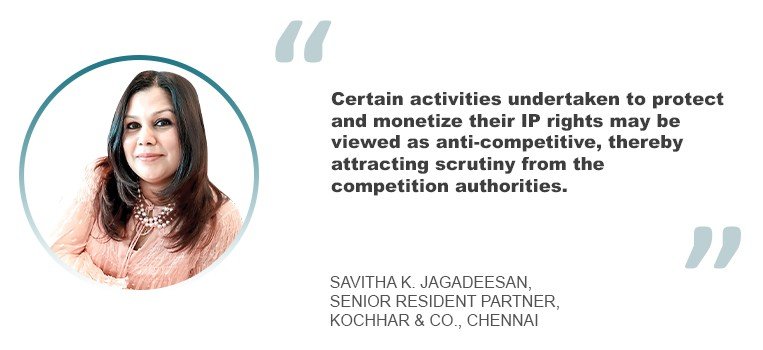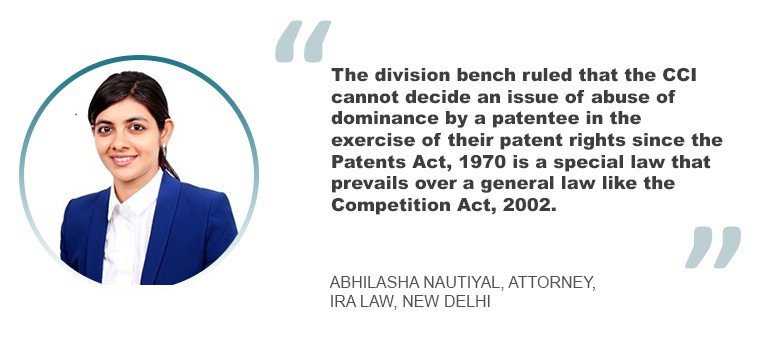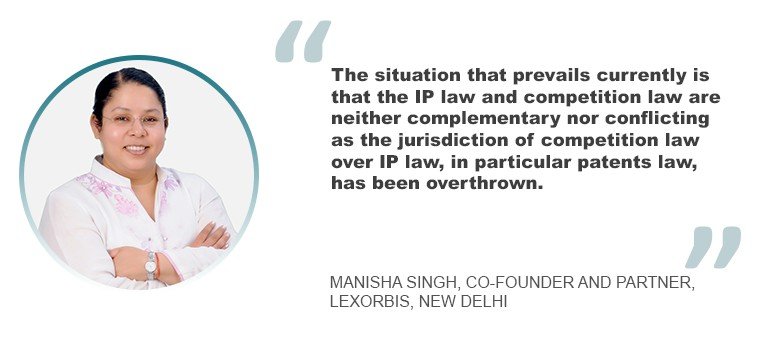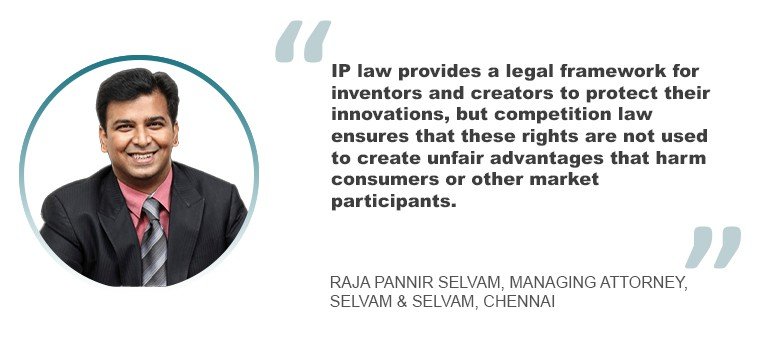India’s IP and competition laws: Complementary or conflicting?
31 January 2024

Indian IP owners face a delicate balance between commercialization and running afoul of the country’s competition law. Espie Angelica A. de Leon explains.
In India, one of the roadblocks to intellectual property commercialization is the question of whether the country’s legislation on IP and competition are complementary or conflicting.
IP law exists to promote an environment conducive to innovation. It grants IP owners exclusive rights and temporary monopoly. By doing so, it lessens competition in the market.
Competition law, also known as anti-trust law, governed primarily in India by the Competition Act of 2002, aims to promote competition while also encouraging innovation.
From this seeming disconnect, challenges could arise for IP rights holders.
“One of the major concerns is that India's IP law, specifically the Patent Act, allows for the grant of compulsory licenses in certain circumstances, enabling third parties to use or manufacture patented products without the consent of the patent holder,” said Savitha K. Jagadeesan, senior resident partner at Kochhar & Co. in Chennai. “This provision, while intended to promote access to affordable healthcare and foster competition, can create uncertainties for companies investing in R&D in India.”

The Competition Act’s objectives of preventing unfair trade practices, anti-competitive agreements and abuse of dominant positions add to IP rights owners’ woes. “Certain activities undertaken to protect and monetize their IP rights may be viewed as anti-competitive,” said Jagadeesan, “thereby attracting scrutiny from the competition authorities.” In particular, Section 3(4) of the Competition Act expressly prohibits tie-in arrangements, exclusive supply agreements, exclusive distribution agreements, refusal to deal and resale price maintenance.
Regarding resale price maintenance, one case involved Maruti Suzuki India Limited. The Indian subsidiary of Suzuki Motor Corporation was accused of fixing the minimum resale price of its cars. Such action restricts fair competition among dealers. Likewise, it limits consumer choice.

“This case underscored the delicate balance required between protecting a company’s brand and ensuring fair market practices, thereby revealing the challenges businesses face in navigating these legal realms, but also ensures that consumers could benefit from a range of choices and competitive pricing, fostering a consumer-centric marketplace,” said Harsha Aswani, an associate at Khurana & Khurana in Noida.
The same holds true for loss leading, or intentionally selling products below cost. “While these practices might initially appear beneficial to consumers due to lower prices, they can have repercussions on fair competition. Predatory pricing strategies like these might erode the market presence of smaller competitors unable to sustain such pricing models,” Aswani explained.
Viewpoints
Considering the two pieces of legislation as complementary is the logical view to consider because viewing them as conflicting may lead to less efficient outcomes overall, say lawyers at Ira Law in New Delhi.

“While India’s IP law and competition law should be complied with while commercializing IP in India, the compliance under these laws is unlikely to be more onerous than that in developed jurisdictions,” Binny Kalra, an attorney at Ira Law in New Delhi, stressed. “There are some areas in IP law that could be viewed as potentially overlapping with competition law, which we would term as a ‘wrinkle’ rather than a major business concern. These wrinkles must necessarily be ironed out by courts in disputes where a party on either side challenges the jurisdiction of the courts or the Competition Commission of India (CCI), as the case may be.”

Citing the July 13, 2023, decision in Telefonaktiebolaget LM Ericson v. Competition Commission of India, Abhilasha Nautiyal, an attorney at Ira Law, offered an example. She said: “A two judge division bench of the Delhi High Court reversed a single judge’s order that upheld the jurisdiction of the CCI in matters relating to patent licensing. The division bench ruled that the CCI cannot decide an issue of abuse of dominance by a patentee in the exercise of their patent rights since the Patents Act, 1970 is a special law that prevails over a general law like the Competition Act, 2002 as far as the exercise of patent rights is concerned. This decision has been appealed to the Supreme Court of India.”
According to Manisha Singh, co-founder and partner at LexOrbis in New Delhi, the aforementioned decision has quashed questions of whether IP and competition laws are complementary or conflicting.

“Thus, unless this decision is overturned by the Supreme Court of India, which is not likely, the situation that prevails currently is that the IP law and competition law are neither complementary nor conflicting as the jurisdiction of competition law over IP law, in particular patents law, has been overthrown,” said Singh.
For Jagadeesan, the laws may be viewed as two sides of the same coin, sharing common goals achieved through different means.
“It encourages dynamic competition by limiting static competition,” she said. “IP rights give owners an advantage over their competitors by allowing them to commercialize their products for a specific period of time. It goes without saying that during this period, IPR holders will still have monopoly power and a dominant position. Monopolistic practice has never been prohibited by competition law,” she stated, “but abuse of that position constitutes a violation of antitrust law.”
Jagadeesan mentioned Section 3(5) of the Indian Competition Act, 2002, saying it includes a general exemption to IP rights. This exemption clause provides for reasonable restrictions for agreements falling under Sections 3(3) and 3(4) of the act, which is made to protect IP rights under various statutes. However, this exception is not absolute. These IPR-related restrictions must be in line with the restrictions under Section 4 of the Competition Act which states that no enterprise shall abuse its dominant position and impose unfair or discriminatory practices in conditions in the purchase or sale of goods or services, or prices in the purchase or sale of goods or services. “The idea behind competition law is not to snuff it,” said Jagadeesan, “but allow the right type of competition to grow. It is to allow direction to the market.”

According to Raja Pannir Selvam, managing attorney at Selvam & Selvam in Chennai, the answer to the question depends on the specific circumstances and how they are applied. “IP law provides a legal framework for inventors and creators to protect their innovations, but competition law ensures that these rights are not used to create unfair advantages that harm consumers or other market participants. So, in essence, they can be seen as complementary in the sense that they both contribute to a balanced and competitive business environment,” explained Selvam. “However, conflicts can arise when businesses misuse their IP rights to create and maintain monopolies, and the CCI helps in to address such issues.”
“India’s IP law and competition law work in tandem,” Aswani added, “providing a system of checks and balances to foster innovation while preventing abuse of exclusive rights.” But, conflicts do emerge, she admitted, “due to the inherent tension between fostering innovation through exclusivity and maintaining a level playing field in the market.”
Action plan for businesses when commercializing IP
To navigate through these challenges, our interviewees said companies should adopt a strategic approach balancing innovation with compliance by doing the following:
- Evaluate plans and their implications before attempting to commercialize IP. “If actions are taken with extreme caution, conflicts and legal disputes that may arise can be easily avoided,” said Jagadeesan.
- Have a comprehensive understanding of IP and competition laws specific to their industry. This means having to regularly monitor industry regulations and keeping abreast of legal developments specific to their industrial sector especially in the face of a constantly evolving business landscape. This will enable enterprises to identify potential conflicts and compliance issues early on. “This includes grappling with issues stemming from technological advancements, digital markets and innovative business strategies,” said Aswani.
- Create a comprehensive IP strategy. The IP strategy must align with competition law requirements to help businesses avoid conflicts.
- Take a risk management approach. “Companies might consider developing risk matrices or frameworks that categorize and prioritize potential risks arising from IP commercialization. This could involve scenario planning, creating response plans and regularly evaluating and updating these strategies to remain agile in the face of evolving legal landscapes,” Aswani said.
- Offer FRAND terms of license. “The earlier challenge posed by the competition law is not there anymore,” Singh said. “The companies that hold IP rights must now meet the obligations of the standard setting bodies for licensing their technology on fair, reasonable and non-discriminatory (FRAND) terms and comply with the requirements of the Patents Act. Offering FRAND terms of license can easily navigate the companies through the only remaining challenges posed by IP laws in India.”
Singh says her firm has assisted clients in finalizing terms of licensing that conform to FRAND requirements as well as the Indian Patents Act, 1970. In S3G Technology LLC v. SourceTrace Systems India Pvt. Ltd. [CS(COMM) 316 of 2020, the firm instituted an infringement suit against a party in India found to be using the patentee’s technology relating to SAAS-based platform. “Amongst the usual challenge of invalidity of patent, the defendants raised a ground that the patentee had not been using its invention in India, which, as mentioned before, is one of the grounds of grant of compulsory licensing. However, before the court could decide on this ground, the defendant agreed to settle and obtain license. We assisted the client in terms of licensing and the suit is being decreed in terms of settlement,” Singh said.
- Have tailored agreements, especially for licensing, collaborations or partnerships. “The goal while working on any agreement related to IP and competition law is to strike a balance between leveraging the client’s IP rights for commercialization while avoiding any potential violations of competition laws,” said Aswani. These agreements must clearly define terms, rights, obligations and restrictions to prevent possible misunderstandings from spiraling into legal issues. “This requires a careful review of contractual terms and conditions to align them with the dual objectives of IP protection and fair competition,” Aswani added. Hence, agreements must always be rigorously vetted by legal counsel.
- Avoid practices that could be seen as anti-competitive. Such practices include patent thickets, abusive licensing agreements and using IP to exclude competitors unfairly, among others.
- Set up internal compliance protocols. “Companies should establish clear and concise policies tailored to their specific operations, incorporating easy-to-understand guidelines and scenarios relevant to day-to-day activities, while emphasizing ethical conduct, fair competition practices and protection of intellectual assets,” said Aswani.
Regular training sessions may be conducted, highlighting critical aspects of compliance and providing practical examples to ensure better assimilation and application within the workplace. It is recommended that these sessions be structured in short, interactive formats to engage employees effectively.
- Allocate resources and investments for continuous innovation and R&D efforts. Strong R&D investments can strengthen a company’s IP portfolio while adhering to fair competition practices.
- Engage and network with industry peers. Learn best practices, legal trends and potential challenges by actively participating in industry forums or associations and networking with peers and stakeholders.
- Engage competent legal experts and compliance teams proficient in both IP and competition laws. Not only will they give strategic guidance; they will also assist in structuring agreements, ensure compliance with laws and mitigate risks associated with commercializing IP.
According to Selvam, India’s approach to IP and competition law may evolve over time. Thus, he added it is important to stay updated on any changes in legislation or shifts in enforcement priorities. “Moreover, promoting innovation while ensuring fair competition is a delicate balance, and it's essential for policymakers to strike the right equilibrium between these two objectives. Businesses should continue to monitor developments in this area to remain compliant and competitive in the Indian market,” he said.






